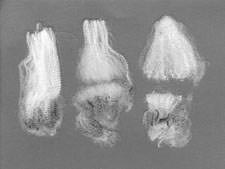





| Home | The Start | The Sheep | The Articles | The Rugs | The Book | Our Blog | Contact Us |
| Originally published in the June 2000 issue of Marker, quarterly magazine of the National Colored Wool Growers Association. Reproduced here with permission. See also Part 1, The Basics and Part 3,
Harvesting and Handling. Wool is keratin, the same protein found in hair, nails, and horns. The structure of the fiber allows for moisture absorption, flame retardation, insulation, and resilience. Wool production is largely dependent on fleece weight and staple length. The quality of the fleece produced begins with the real producer - the sheep. While there are things about a fleece that we can improve, there are other things that we cannot change and have no control over. Some things about an individual sheep's fleece that we cannot change include: Genetics All things equal, wool type and quality is genetically determined. The ewe, but especially the ram, should have the genetic capability of producing top-quality fleeces of their own in order to produce lambs with superior wool. Wool traits are highly heritable. Heritability estimates are high enough that the mating together of the best individuals for two traits alone, fleece weight and staple length, should result in fleece improvement. Other highly heritable traits include yield, fiber diameter, density, color, and medulation. Genetic Influences | ||||
| ||||
| Inherited Deficiencies Wool faults are defects that lower the value; breeding faults can be controlled. The following list shows major inherited deficiencies:
Some things about a fleece we can change and have the power to improve, including: Nutrition: Poor nutrition results in poor fleece growth, thin, fine, wispy, harsh, and brittle wool. Good nutrition can result in dense, lustrous growth, with great handle and spinability. A balanced diet is essential and should be maintained year-round. A mixed-grass pasture, or hay, is ideal, but should always be supplemented with a free-choice salt/mineral/vitamin mix, as well as clean water. Wool consists of two main fractions: the wool fiber and the yolk or grease. The fiber is practically pure sulfur-containing protein. The grease fraction is made up of a water soluble fraction called suint and a water insoluble fraction called lanolin. Nutritive requirements for wool production are over and above those needed for growth and maintenance, in fact these requirements can be considerable. The primary requirements needed for wool production are sulfur-containing protein, energy, potassium. |
| Factors for fleece growth Feed > Fermentation in the rumen > Nutrients absorbed into the blood stream > Metabolic pool > Raw materials and energy for wool growth, including Primary follicles and Secondary follicles. |
| We can start supplementing the ewe diet with additional protein early in gestation to select for 'secondary follicle' development, as discussed in Part 1. Increasing
the numbers of secondary wool follicles can result in denser fleeces.
At about 90 days into gestation these secondary follicles are formed. They can produce as many as eight fibers from one follicle, if the conditions are optimum. These follicles also produce finer fibers and lack the sweat glands found in the primary follicles. In contrast the �primary follicles', produced earlier in gestation (between 50-90 days), result in only one fiber being produced and that one could be a medulated fiber. They also contain sweat and sebaceous glands. In the birth coat the presence of halo hairs, sickle fibers and some types of curly-tips are associated with primary follicles, while the preferred later maturing curly-tips and histerotrichs are associated with secondary follicular development. Energy Feeds vs High-Protein Feeds If we want to boost the protein levels to the pregnant ewe, for instance, without getting her too fat, we could select high protein meals in a pelleted form. If energy is needed for growth or fattening then we could select from the list of energy feeds with high total digestible nutrients. See Table #1 - Feed Type. |
| Feed Type | TDN (Total Digestible Nutrients) | Protein Levels |
|---|---|---|
| Energy Feeds | ||
| Shelled Corn | 78% | 9% |
| Oats | 66% | 12% |
| Barley | 72% | 12% |
| Wheat Grain | 78% | 12% |
| Wheat Bran | 63% | 9% |
| Protein Feeds | ||
| Fish Meal | 68% | 60% |
| Soybean Oil Meal | 72% | 44% |
| Cottonseed Meal | 74% | 44% |
| Peanut Oil Meal | 70% | 45% |
| Linseed Oil Meal | 74% | 35% |
Notes
|
| Health: A healthy sheep feels good, has a healthy appetite and grows the best fleece it is capable of producing. Stress, lambing, illness, weather and parasites all put a burden on the production of a beautiful fleece and often results in weak or tender fibers. |  Breaks in Wool Locks |
| Environment: Burrs, thistles, dirt, mud, hay, chaff, manure, sun, and heat will decrease the value of wool on a sheep. Keeping sheep on clean pasture, but with access to shade, will eliminate many of the damaging factors. A good hard cool rain will do wonders for a fleece, as long as the weather is not hot, steamy and humid. During the latter conditions, sheep seem to love to find something to rub on. And we know what water, heat and friction does to wool: it makes felt. To Summarize In order to improve the wool on our sheep we must:
|
| Home | The Start | The Sheep | The Articles | The Rugs | The Book | Our Blog | Contact Us |


